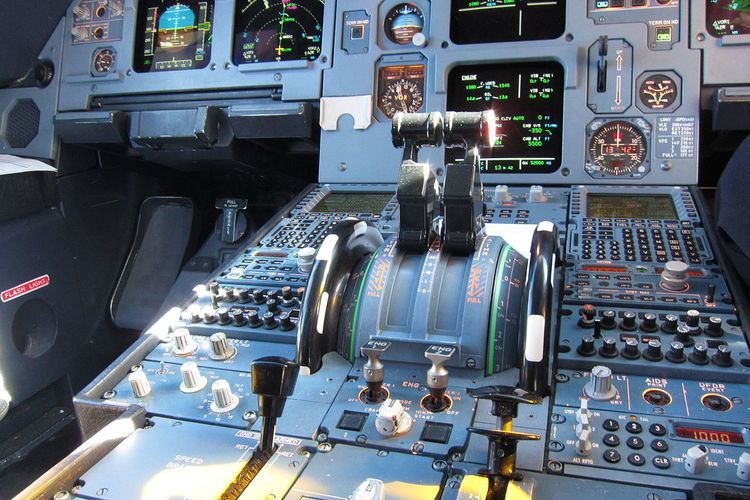 | ||
An autothrottle (automatic throttle) allows a pilot to control the power setting of an aircraft's engines by specifying a desired flight characteristic, rather than manually controlling the fuel flow. These systems can conserve fuel and extend engine life by metering the precise amount of fuel required to attain a specific target indicated air speed, or the assigned power for different phases of flight. A/T and AFDS (Auto Flight Director Systems) work together to fulfill the whole flight plan and greatly reduce the pilots' work load.
Contents
Working modes
There are two parameters that an A/T (autothrottle) can maintain, or try to attain: speed and thrust.
In speed mode the throttle is positioned to attain a set target speed. This mode controls aircraft speed within safe operating margins. For example, if the pilot selects a target speed which is slower than stall speed, or a speed faster than maximum speed, the autothrottle system will maintain a speed closest to the target speed that is within the range of safe speeds.
In the thrust mode the engine is maintained at a fixed power setting according to the different flight phases. For example, during takeoff, A/T maintains constant takeoff power until takeoff mode is finished. During climb, A/T maintains constant climb power; in descent, A/T retards the throttle to IDLE position, and so on. When A/T is working in thrust mode, speed is controlled by pitch (or the control column), and NOT protected by A/T. A radar altimeter feeds data to the autothrottle mostly in this mode. (In Boeing it feeds data to the autothrottle every time. See below.)
Usage
On Boeing-type aircraft, A/T can be used in all flight phases from takeoff, climb, cruise, descent, approach, all the way to land or go-around, barring malfunction. Taxi is not considered a part of flight, and A/T does not work for taxiing. In most cases, A/T mode selection is automatic without the need of any manual selection unless interrupted by pilots.
According to Boeing-published flight procedures, A/T is engaged BEFORE the takeoff procedure and is automatically disconnected two seconds after landing. During flight, manual override of A/T is always available. A release of manual override allows A/T to regain control, and the throttle will go back to the A/T commanded position except for two modes (Boeing type aircraft): IDLE and THR HLD. In these two modes, the throttle will remain at the manual commanded position.
Origins
A primitive autothrottle was first fitted to later versions of the Messerschmitt Me 262 jet fighter late in World War II. Today it is often linked to a Flight Management System, and FADEC is an extension of the concept to control many other parameters besides fuel flow.
